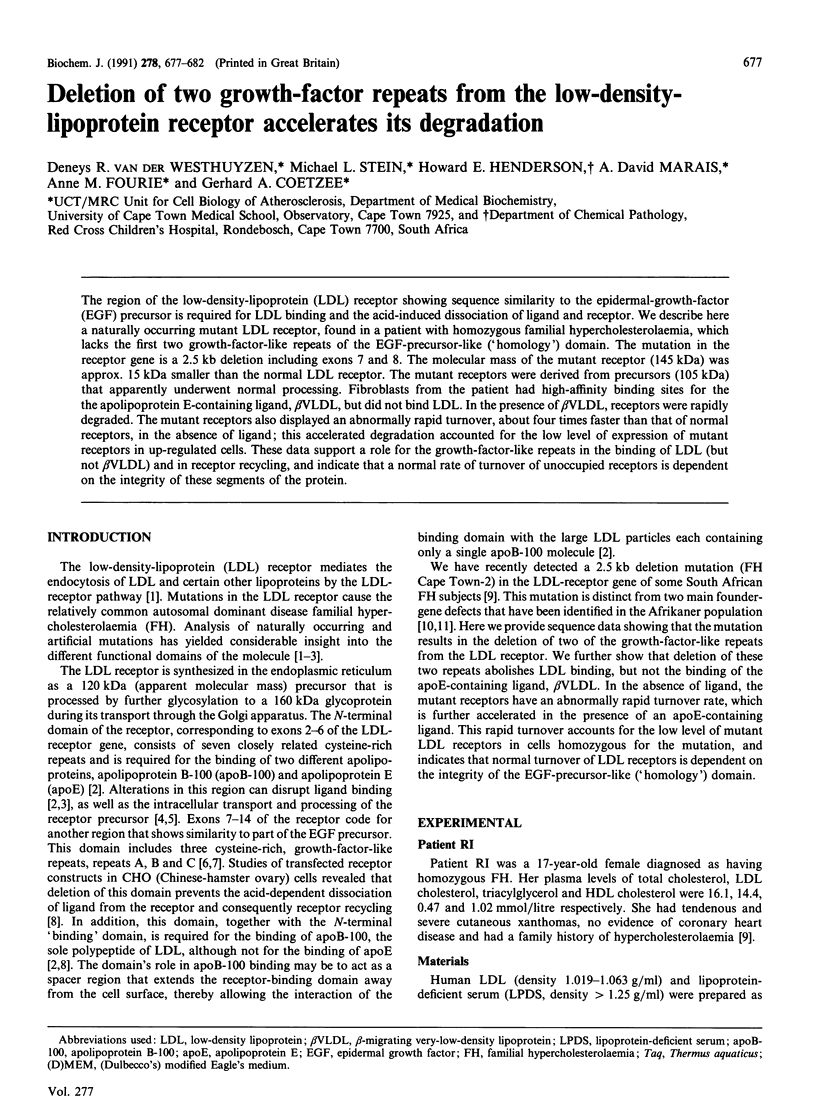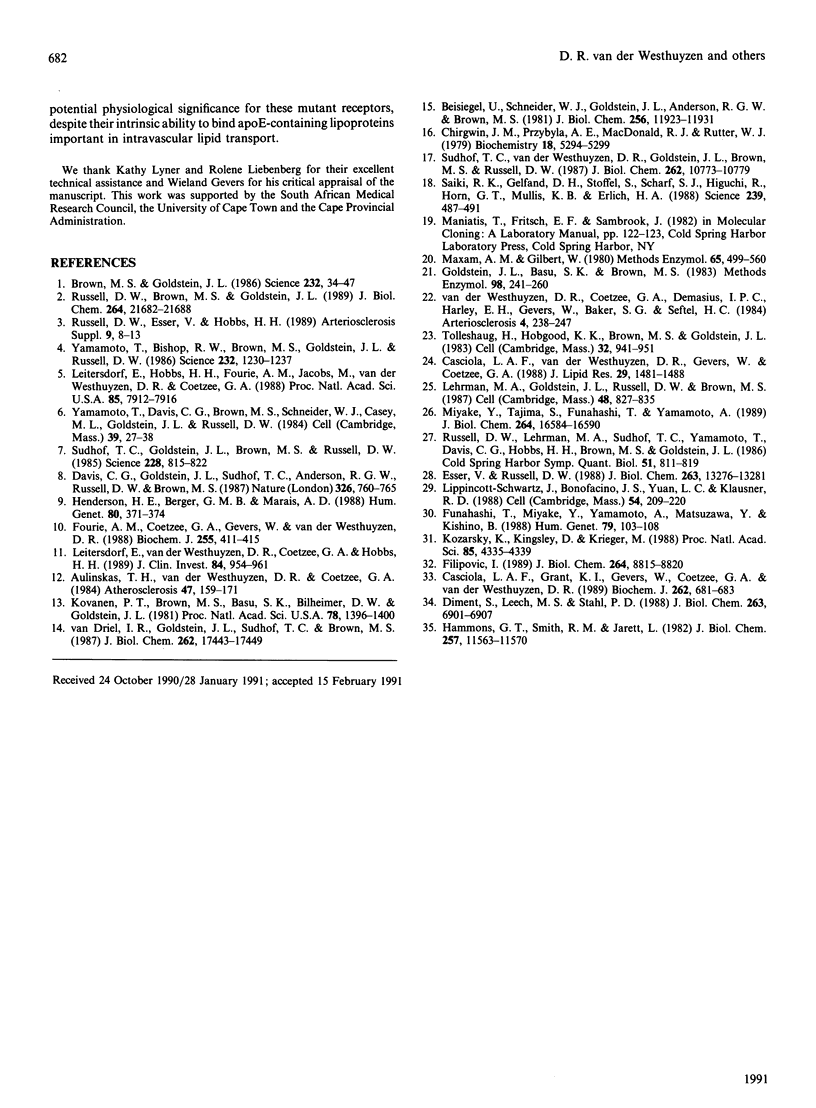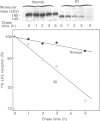Abstract
The region of the low-density-lipoprotein (LDL) receptor showing sequence similarity to the epidermal-growth-factor (EGF) precursor is required for LDL binding and the acid-induced dissociation of ligand and receptor. We describe here a naturally occurring mutant LDL receptor, found in a patient with homozygous familial hypercholesterolaemia, which lacks the first two growth-factor-like repeats of the EGF-precursor-like ('homology') domain. The mutation in the receptor gene is a 2.5 kb deletion including exons 7 and 8. The molecular mass of the mutant receptor (145 kDa) was approx. 15 kDa smaller than the normal LDL receptor. The mutant receptors were derived from precursors (105 kDa) that apparently underwent normal processing. Fibroblasts from the patient had high-affinity binding sites for the the apolipoprotein E-containing ligand, beta VLDL, but did not bind LDL. In the presence of beta VLDL, receptors were rapidly degraded. The mutant receptors also displayed an abnormally rapid turnover, about four times faster than that of normal receptors, in the absence of ligand; this accelerated degradation accounted for the low level of expression of mutant receptors in up-regulated cells. These data support a role for the growth-factor-like repeats in the binding of LDL (but not beta VLDL) and in receptor recycling, and indicate that a normal rate of turnover of unoccupied receptors is dependent on the integrity of these segments of the protein.
Full text
PDF





Images in this article
Selected References
These references are in PubMed. This may not be the complete list of references from this article.
- Aulinskas T. H., Van der Westhuyzen D. R., Coetzee G. A. Ascorbate increases the number of low density lipoprotein receptors in cultured arterial smooth muscle cells. Atherosclerosis. 1983 May;47(2):159–171. doi: 10.1016/0021-9150(83)90152-1. [DOI] [PubMed] [Google Scholar]
- Beisiegel U., Schneider W. J., Goldstein J. L., Anderson R. G., Brown M. S. Monoclonal antibodies to the low density lipoprotein receptor as probes for study of receptor-mediated endocytosis and the genetics of familial hypercholesterolemia. J Biol Chem. 1981 Nov 25;256(22):11923–11931. [PubMed] [Google Scholar]
- Brown M. S., Goldstein J. L. A receptor-mediated pathway for cholesterol homeostasis. Science. 1986 Apr 4;232(4746):34–47. doi: 10.1126/science.3513311. [DOI] [PubMed] [Google Scholar]
- Casciola L. A., Grant K. I., Gevers W., Coetzee G. A., van der Westhuyzen D. R. Low-density-lipoprotein receptors in human fibroblasts are not degraded in lysosomes. Biochem J. 1989 Sep 1;262(2):681–683. doi: 10.1042/bj2620681. [DOI] [PMC free article] [PubMed] [Google Scholar]
- Casciola L. A., van der Westhuyzen D. R., Gevers W., Coetzee G. A. Low density lipoprotein receptor degradation is influenced by a mediator protein(s) with a rapid turnover rate, but is unaffected by receptor up- or down-regulation. J Lipid Res. 1988 Nov;29(11):1481–1489. [PubMed] [Google Scholar]
- Chirgwin J. M., Przybyla A. E., MacDonald R. J., Rutter W. J. Isolation of biologically active ribonucleic acid from sources enriched in ribonuclease. Biochemistry. 1979 Nov 27;18(24):5294–5299. doi: 10.1021/bi00591a005. [DOI] [PubMed] [Google Scholar]
- Davis C. G., Goldstein J. L., Südhof T. C., Anderson R. G., Russell D. W., Brown M. S. Acid-dependent ligand dissociation and recycling of LDL receptor mediated by growth factor homology region. Nature. 1987 Apr 23;326(6115):760–765. doi: 10.1038/326760a0. [DOI] [PubMed] [Google Scholar]
- Diment S., Leech M. S., Stahl P. D. Cathepsin D is membrane-associated in macrophage endosomes. J Biol Chem. 1988 May 15;263(14):6901–6907. [PubMed] [Google Scholar]
- Esser V., Russell D. W. Transport-deficient mutations in the low density lipoprotein receptor. Alterations in the cysteine-rich and cysteine-poor regions of the protein block intracellular transport. J Biol Chem. 1988 Sep 15;263(26):13276–13281. [PubMed] [Google Scholar]
- Filipovic I. Effect of inhibiting N-glycosylation on the stability and binding activity of the low density lipoprotein receptor. J Biol Chem. 1989 May 25;264(15):8815–8820. [PubMed] [Google Scholar]
- Fourie A. M., Coetzee G. A., Gevers W., van der Westhuyzen D. R. Two mutant low-density-lipoprotein receptors in Afrikaners slowly processed to surface forms exhibiting rapid degradation or functional heterogeneity. Biochem J. 1988 Oct 15;255(2):411–415. doi: 10.1042/bj2550411. [DOI] [PMC free article] [PubMed] [Google Scholar]
- Funahashi T., Miyake Y., Yamamoto A., Matsuzawa Y., Kishino B. Mutations of the low density lipoprotein receptor in Japanese kindreds with familial hypercholesterolemia. Hum Genet. 1988 Jun;79(2):103–108. doi: 10.1007/BF00280546. [DOI] [PubMed] [Google Scholar]
- Goldstein J. L., Basu S. K., Brown M. S. Receptor-mediated endocytosis of low-density lipoprotein in cultured cells. Methods Enzymol. 1983;98:241–260. doi: 10.1016/0076-6879(83)98152-1. [DOI] [PubMed] [Google Scholar]
- Hammons G. T., Smith R. M., Jarett L. Inhibition by bacitracin of rat adipocyte plasma membrane degradation of 125I-insulin is associated with an increase in plasma membrane bound insulin and a potentiation of glucose oxidation by adipocytes. J Biol Chem. 1982 Oct 10;257(19):11563–11570. [PubMed] [Google Scholar]
- Henderson H. E., Berger G. M., Marais A. D. A new LDL receptor gene deletion mutation in the South African population. Hum Genet. 1988 Dec;80(4):371–374. doi: 10.1007/BF00273653. [DOI] [PubMed] [Google Scholar]
- Kovanen P. T., Brown M. S., Basu S. K., Bilheimer D. W., Goldstein J. L. Saturation and suppression of hepatic lipoprotein receptors: a mechanism for the hypercholesterolemia of cholesterol-fed rabbits. Proc Natl Acad Sci U S A. 1981 Mar;78(3):1396–1400. doi: 10.1073/pnas.78.3.1396. [DOI] [PMC free article] [PubMed] [Google Scholar]
- Kozarsky K., Kingsley D., Krieger M. Use of a mutant cell line to study the kinetics and function of O-linked glycosylation of low density lipoprotein receptors. Proc Natl Acad Sci U S A. 1988 Jun;85(12):4335–4339. doi: 10.1073/pnas.85.12.4335. [DOI] [PMC free article] [PubMed] [Google Scholar]
- Lehrman M. A., Goldstein J. L., Russell D. W., Brown M. S. Duplication of seven exons in LDL receptor gene caused by Alu-Alu recombination in a subject with familial hypercholesterolemia. Cell. 1987 Mar 13;48(5):827–835. doi: 10.1016/0092-8674(87)90079-1. [DOI] [PubMed] [Google Scholar]
- Leitersdorf E., Hobbs H. H., Fourie A. M., Jacobs M., van der Westhuyzen D. R., Coetzee G. A. Deletion in the first cysteine-rich repeat of low density lipoprotein receptor impairs its transport but not lipoprotein binding in fibroblasts from a subject with familial hypercholesterolemia. Proc Natl Acad Sci U S A. 1988 Nov;85(21):7912–7916. doi: 10.1073/pnas.85.21.7912. [DOI] [PMC free article] [PubMed] [Google Scholar]
- Leitersdorf E., Van der Westhuyzen D. R., Coetzee G. A., Hobbs H. H. Two common low density lipoprotein receptor gene mutations cause familial hypercholesterolemia in Afrikaners. J Clin Invest. 1989 Sep;84(3):954–961. doi: 10.1172/JCI114258. [DOI] [PMC free article] [PubMed] [Google Scholar]
- Lippincott-Schwartz J., Bonifacino J. S., Yuan L. C., Klausner R. D. Degradation from the endoplasmic reticulum: disposing of newly synthesized proteins. Cell. 1988 Jul 15;54(2):209–220. doi: 10.1016/0092-8674(88)90553-3. [DOI] [PubMed] [Google Scholar]
- Maxam A. M., Gilbert W. Sequencing end-labeled DNA with base-specific chemical cleavages. Methods Enzymol. 1980;65(1):499–560. doi: 10.1016/s0076-6879(80)65059-9. [DOI] [PubMed] [Google Scholar]
- Miyake Y., Tajima S., Funahashi T., Yamamoto A. Analysis of a recycling-impaired mutant of low density lipoprotein receptor in familial hypercholesterolemia. J Biol Chem. 1989 Oct 5;264(28):16584–16590. [PubMed] [Google Scholar]
- Russell D. W., Brown M. S., Goldstein J. L. Different combinations of cysteine-rich repeats mediate binding of low density lipoprotein receptor to two different proteins. J Biol Chem. 1989 Dec 25;264(36):21682–21688. [PubMed] [Google Scholar]
- Russell D. W., Esser V., Hobbs H. H. Molecular basis of familial hypercholesterolemia. Arteriosclerosis. 1989 Jan-Feb;9(1 Suppl):I8–13. [PubMed] [Google Scholar]
- Russell D. W., Lehrman M. A., Südhof T. C., Yamamoto T., Davis C. G., Hobbs H. H., Brown M. S., Goldstein J. L. The LDL receptor in familial hypercholesterolemia: use of human mutations to dissect a membrane protein. Cold Spring Harb Symp Quant Biol. 1986;51(Pt 2):811–819. doi: 10.1101/sqb.1986.051.01.094. [DOI] [PubMed] [Google Scholar]
- Saiki R. K., Gelfand D. H., Stoffel S., Scharf S. J., Higuchi R., Horn G. T., Mullis K. B., Erlich H. A. Primer-directed enzymatic amplification of DNA with a thermostable DNA polymerase. Science. 1988 Jan 29;239(4839):487–491. doi: 10.1126/science.2448875. [DOI] [PubMed] [Google Scholar]
- Südhof T. C., Goldstein J. L., Brown M. S., Russell D. W. The LDL receptor gene: a mosaic of exons shared with different proteins. Science. 1985 May 17;228(4701):815–822. doi: 10.1126/science.2988123. [DOI] [PMC free article] [PubMed] [Google Scholar]
- Südhof T. C., Van der Westhuyzen D. R., Goldstein J. L., Brown M. S., Russell D. W. Three direct repeats and a TATA-like sequence are required for regulated expression of the human low density lipoprotein receptor gene. J Biol Chem. 1987 Aug 5;262(22):10773–10779. [PubMed] [Google Scholar]
- Tolleshaug H., Hobgood K. K., Brown M. S., Goldstein J. L. The LDL receptor locus in familial hypercholesterolemia: multiple mutations disrupt transport and processing of a membrane receptor. Cell. 1983 Mar;32(3):941–951. doi: 10.1016/0092-8674(83)90079-x. [DOI] [PubMed] [Google Scholar]
- Yamamoto T., Bishop R. W., Brown M. S., Goldstein J. L., Russell D. W. Deletion in cysteine-rich region of LDL receptor impedes transport to cell surface in WHHL rabbit. Science. 1986 Jun 6;232(4755):1230–1237. doi: 10.1126/science.3010466. [DOI] [PMC free article] [PubMed] [Google Scholar]
- Yamamoto T., Davis C. G., Brown M. S., Schneider W. J., Casey M. L., Goldstein J. L., Russell D. W. The human LDL receptor: a cysteine-rich protein with multiple Alu sequences in its mRNA. Cell. 1984 Nov;39(1):27–38. doi: 10.1016/0092-8674(84)90188-0. [DOI] [PubMed] [Google Scholar]
- van Driel I. R., Goldstein J. L., Südhof T. C., Brown M. S. First cysteine-rich repeat in ligand-binding domain of low density lipoprotein receptor binds Ca2+ and monoclonal antibodies, but not lipoproteins. J Biol Chem. 1987 Dec 25;262(36):17443–17449. [PubMed] [Google Scholar]
- van der Westhuyzen D. R., Coetzee G. A., Demasius I. P., Harley E. H., Gevers W., Baker S. G., Seftel H. C. Low density lipoprotein receptor mutations in South African homozygous familial hypercholesterolemic patients. Arteriosclerosis. 1984 May-Jun;4(3):238–247. doi: 10.1161/01.atv.4.3.238. [DOI] [PubMed] [Google Scholar]









